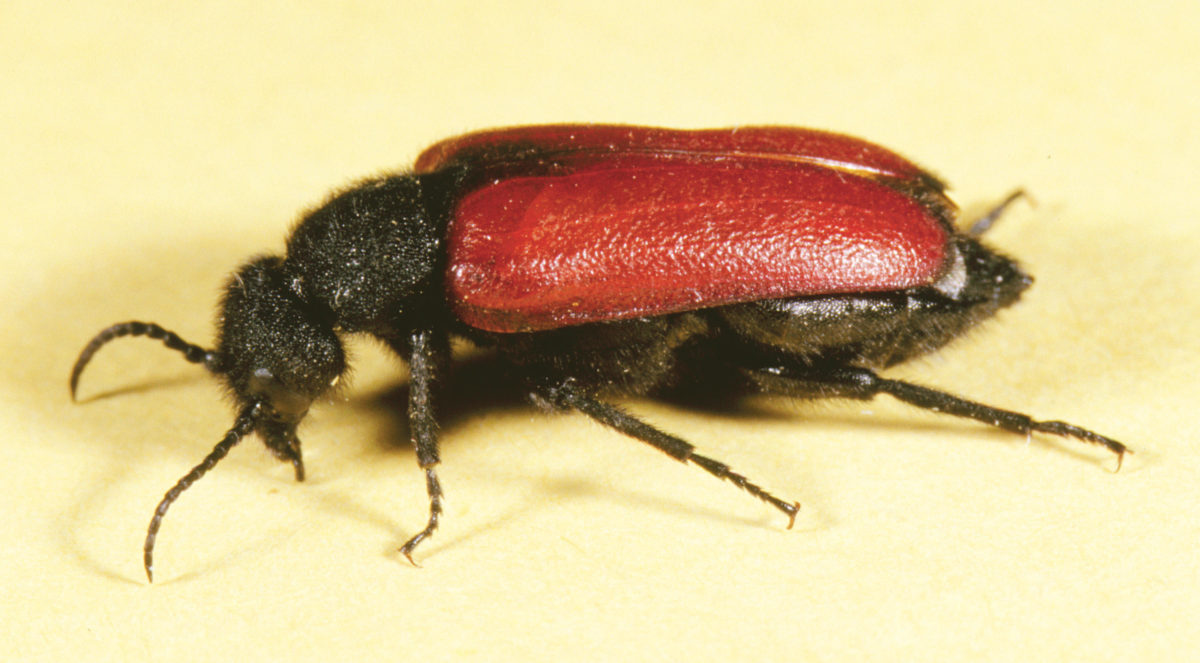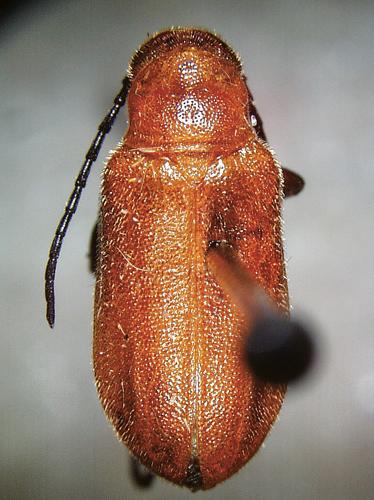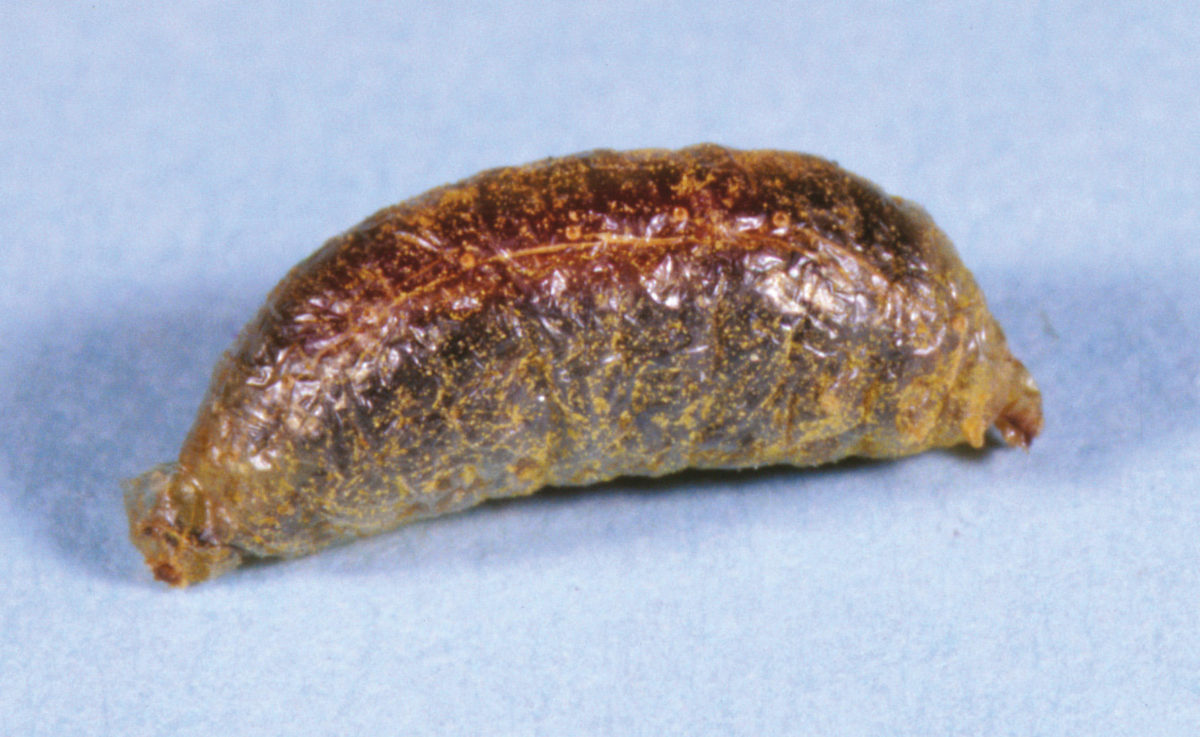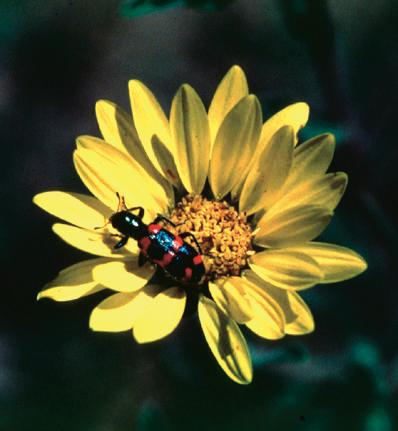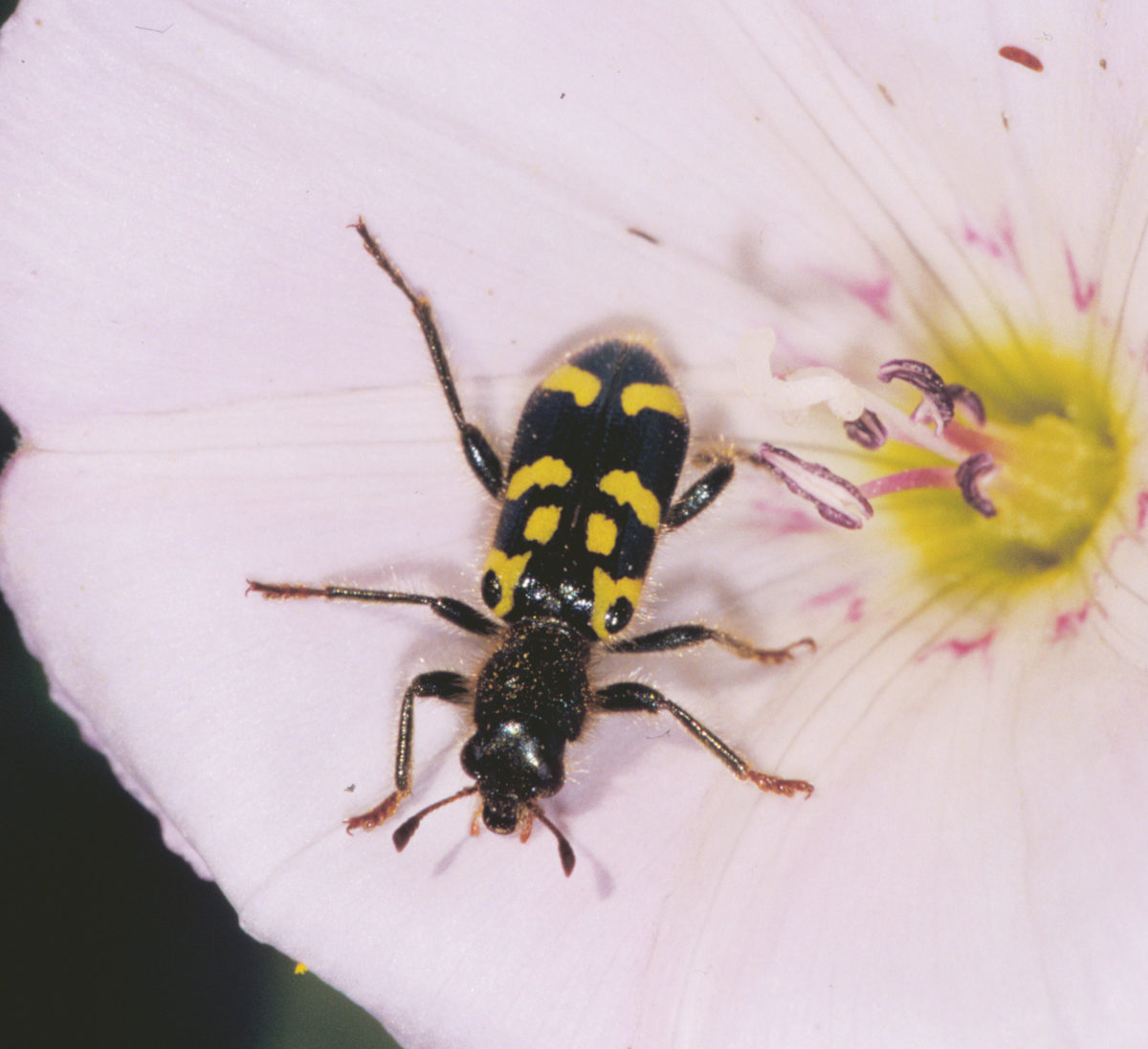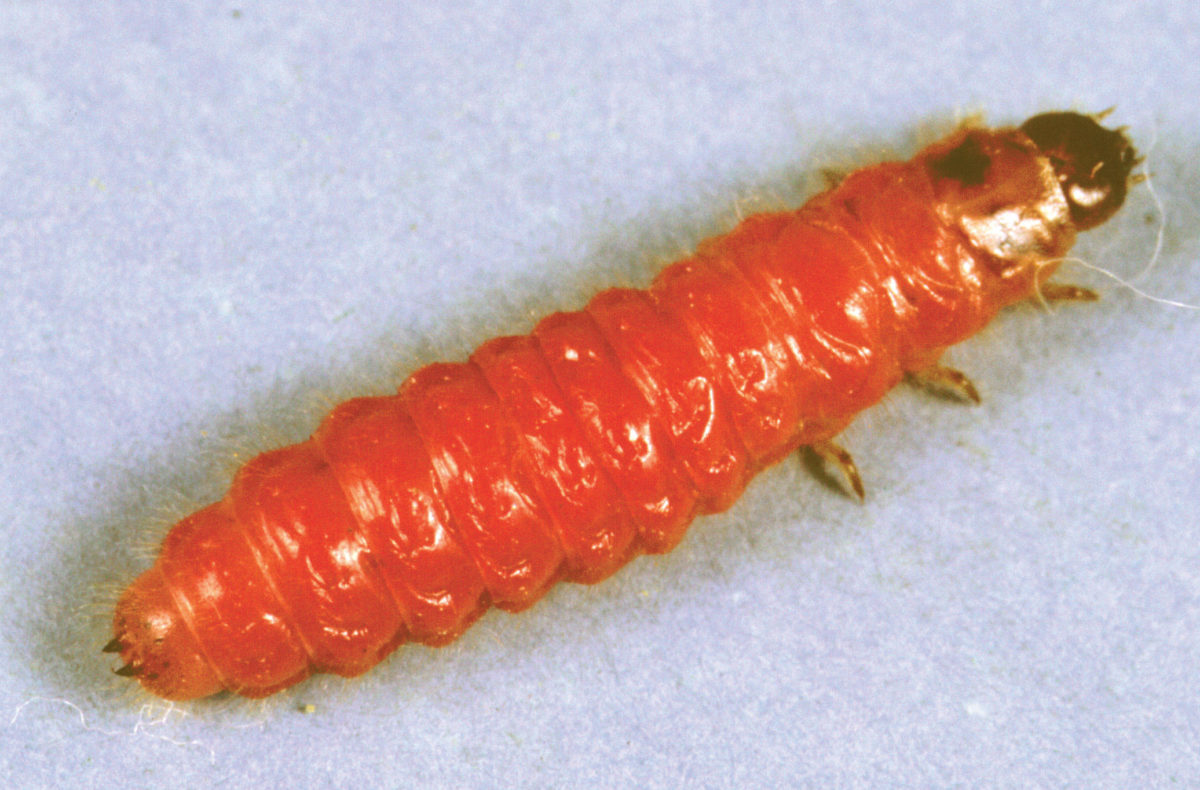Beetles constitute the most diverse insect order on Earth. The vast majority of them are beneficial, preying on crop pests and recycling nutrients. Only a few of them present challenges to beekeepers.
Blister Species
Various species of blister beetles (in the beetle family Meloidae) are common cleptoparasites of many cavity-nesting bees. Tricrania stansburyi, measures up to about 1⁄2 inch (12.7 millimeters) long as an adult and is black with red wing covers (Figure A.12). Adults of Nemognatha lutea and N. vittigera, commonly called brown blister beetles, are the same size but are yellow or brown in color (Figure A.13).
Both beetles have similar lifecycles, with females laying their eggs in large masses on the buds and flowers of many common weedy plants. Upon hatching, the first larval stage (called a triungulin) crawls to the top of the flower and waits for visiting bees. Using claw-studded legs, the triungulins grasp the hairs of visiting bees and are transported back to the nest cavity where they detach themselves. Within the sealed nest, the beetle larva consumes the pollen-nectar provision and the bee egg. Within mason bee nests, beetle larval movement is normally restricted by the mud partitions. However, within leafcutter bee nests, beetle larvae may move between cells, destroying several in the process.
Development occurs rapidly, and the beetles overwinter either as adults or as pupae. There is a single generation per year, and overwintering beetles are encased within a semi-translucent brown cocoon-like skin called a coarctate (Figure A.14). Loose-cell management of bees allows for the effective separation of bee cocoons and coarctate. Tumbling of bee cells also destroys beetle coarctate, by rupturing the outer membrane causing desiccation. Without control, adult beetles emerge the following spring. Blister beetles are more common in areas with abundant wildflowers than in regions that are intensively farmed.

Figure A.12 Adult blister beetle, Tricrania stansburyi. Photo by D.F. Veirs. 
Figure A.13 Adult brown blister beetle, Nemognathus vittigera. Photo by Cedar Creek Nature Center. 
Figure A.14 Wintering adult blister beetle, Tricrania stansburyi, enclosed within its cocoon-like coarctate. Photo by D.F. Veirs.
Checkered Flower Beetles
Another major cleptoparasite of cavity-nesting bees are the checkered flower beetles, Trichodes ornatus and T. nutalli. Adult beetles measure just over 1⁄2 inch in length (12.7 millimeters) and are dark blue with yellow, orange, or red spotted patterns on their wing covers (figures A.15 and A.16).
Female beetles lay their eggs near the entrances of bee nests. Upon hatching, the first several larval stages (which are white or pink, and up to 1⁄2 inch long) move between nest cavities consuming pollen provisions as well as bee eggs. Larval stages can be recognized by their grub-like appearance and the two prominent spines protruding from the tip of the abdomen (Figure A.17). There is typically one generation per year, with the fourth larval stage overwintering inside a coarctate.
The checkered flower beetle has been associated with both mason bees and leafcutter bees, and pheromone traps have been employed as a control measure among some leafcutter beekeepers. Leafcutter operations in the Pacific Northwest have been most affected, while beekeepers in prairie regions generally have a lower incidence of beetles. As with many parasites, mason beekeepers can avoid most checkered flower beetle damage by promptly removing nests from the field at the end of the nesting period.

Figure A.15 Adult checkered flower beetle, Trichodes nutalli, resting on a sunflower. Photo by Cedar Creek Nature Center. 
Figure A.16 Adult checkered flower beetle, Trichodes ornatus. Photo by J.H. Cane. 
Figure A.17 Checkered flower beetle, Trichodes ornatus, fully grown larva. Note forked spiny process at the tip of the abdomen (left). Photo by D.F. Veirs.
Stored-Product Beetles
Various stored-product beetles are commonly associated with leafcutter and mason bee operations. They include carpet beetles (Trogoderma glabra, T. variabile, Anthrenus verbasci, Attagenus spp., and Megatoma spp.); the red, black and confused flour beetles (Tribolium castaneum, T. audox, and T. confusum); the sawtoothed and rusty grain beetles (Oryzaephilus surinamensis, and Cryptolestes ferrugineus); various spider beetles (Ptinus spp.); and several beetles without common names, including Tribolium brevicornis and Tenebroides maurtanicus.
Larval and adult stages of these beetles are attracted to pollen provisions and are most common in poorly constructed nests or around facilities where grain and seed products are stored. Most are capable of feeding at low temperatures and often have a high reproductive rate with multiple generations per year. Because of this, they may be found in field shelters, nests, incubators, and storage facilities. Sanitation is a critical control factor.
Among the spider beetles, Ptinus californicus has been cited as a common pest in some areas. This beetle lays its eggs within the unsealed cells of bee nests where several larvae may develop, feeding on the pollen provision and in the process starving or injuring the immature bee.
Adult spider beetles are brown with linear white patches on the wing covers, have long antennae, and measure up to about 3/16 inch (~5 millimeters) in length. There is typically one generation per year with adult or larval stages overwintering within the bee nest inside a coarctate. Infested cells are characterized by an abundance of long stringy feces, and sometimes-ragged emergence holes, where adult beetles have exited. Loose-cell management and nesting systems that facilitate cocoon inspection (such as paper straws or laminate boards) are the primary method of control.
The smooth carpet beetle (Trogoderma glabra), another common nest scavenger, has a similar feeding habit. As with other stored-product beetles, adults lay their eggs inside unsealed nest cells. Broken or incomplete cell partitions further facilitate larval movement between cells and egg laying by adults.
Carpet beetles usually measure less than 1⁄8 inch in length (~3 millimeters), are mottled brown, black, tan, and white, and are roughly oval shaped (similar to lady beetles). Larvae may reach almost 3/16 inch in length (~5 millimeters) and are often brown or orange in color and covered with bristles. Multiple generations a year are common.
Flour beetles are a similar size to spider and carpet beetles, 3/16 to 15/64 inch in length (~5 to 6 millimeters). However, adults are usually more stout in appearance, are often brown in color, and have deep groove patterns running lengthwise along the wing covers. The larval stages often have distinct light and dark segmented bodies, with short spine-like protrusions at the tip of the abdomen.

